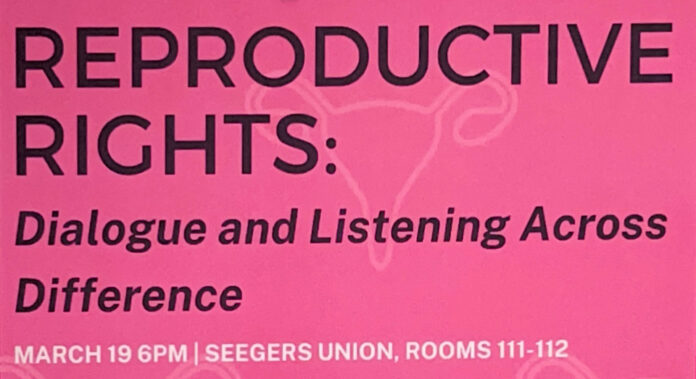In honor of Women’s History Month, the Women and Gender Studies department hosted a dialogue centered around reproductive rights in the aftermath of the Dobbs v. Jackson Women’s Health Organization (2022). The Dobbs decision effectively overturned Roe v. Wade (1973) which had previously ensured abortion as a federal right protected by the US Constitution. Facilitated by Rev. Janelle Neubarer, College Chaplain and Tim Black, director of student transitions and family programs, the event was structured as an opportunity for faculty and students to freely share their reactions to Dobbs and reproductive rights. The event was co-organized by Jennifer Storm, director of equity and Title IX and Neubarer, and included four faculty members who all conducted research and/or teach courses pertaining to women’s health and history.
The dialogue was centered around the individual perspectives of the participants, beginning with the faculty who shared their initial reactions to the overturning of Roe v. Wade and also discussed how they handled occupying dual roles as both professionals who had to react appropriately to the news and a woman whom this legislature directly impacts. Professor of Biology Melissa Dowd, who teaches Introduction to Maternal and Child Health, expressed the difficulty of processing the news initially: “How can I be the one to have all the answers when there are none to be had?” Director of Women and Gender Studies and Professor of Psychology Kate Richmond, Ph.D. added, “This is about lives. This is so much bigger than abortion.”
Beyond processing their own reactions to the news, faculty also expressed their concern at the greater implications of Dobbs. Visiting Assistant Professor Kiah Bennett, Ph.D. who works in the Media & Communication department, pointed to a larger conversation about privilege and accessibility: “If I am feeling this way as a white woman with privilege, I think about women of color with less access. And I feel ashamed because the solidarity that I have shown to marginalized groups in the past has not been as fierce as the solidarity I have now that I am personally affected.” In fact, Bennett’s comment points to a larger trend of the disproportionate rates of women dying in childbirth, as women of color have alarmingly higher mortality rates. Jacqueline D. Antonovich, Ph.D., assistant professor of history, added to this discussion by bringing up the concept of reproductive justice, a term coined by Black feminists in the ‘90s as a way to articulate how the reproductive rights movement often fails to consider factors outside of abortion that greatly impact the lives of people of color.
After the faculty shared their responses to the provided questions, students were broken into small groups headed by a facilitator to answer those same questions. The dialogue provided a space for students to freely voice their opinions and listen to various perspectives. Many students expressed their frustration at the Dobbs decision, while others focused on their fear for the future of reproductive rights. Lily Bernecker ‘27 weighed in on her experience: “It was touching to see the undivided attention that everyone had for each speaker. Everyone in the room was genuinely interested in what was being said. Dialogues like these are so important for advocacy and education.”
During the last ten minutes of the event, everyone gathered back together as a group to note the overarching themes they noticed during their conversations. Many groups discussed feelings of fear and uncertainty towards the future in light of Dobbs, as well as the empowerment that education can provide despite that fear. Overall, participants seemed to connect over the shared sense of community that the dialogue encouraged, and voiced their encouragement for similar events. Antonovich noted, “Structured dialogues like a listening circle are incredibly important because they provide students with the tools and environment to learn to voice their opinions and to listen to others. Based on what I heard from students, this event was one of the first times they engaged in a dialogue like this, largely because they felt safe to do so without judgment.”






















